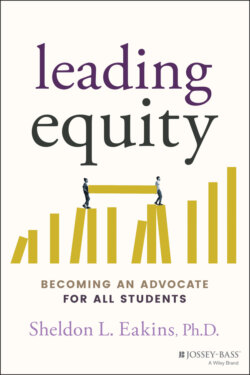Leading Equity

Реклама. ООО «ЛитРес», ИНН: 7719571260.
Оглавление
Sheldon L. Eakins. Leading Equity
Table of Contents
List of Illustrations
Guide
Pages
Praise for Leading Equity
Leading Equity. Becoming an Advocate for All Students
Preface
I'm No Longer an Ally, and Here's Why
Not Doing Anything Is Not Doing Anything
What Are Your Motives?
Becoming a Disruptor
Acknowledgments
About the Author
CHAPTER 1 Know Your Biases and Recognize Your Position of Privilege as an Educator
Dialing Things Back
Assessing Your Affinity Bias
Steps to Building Relationships
Your Bias Is Showing
Implicit Bias and Me
Implicit Bias Analysis Guide
Implicit Bias Talk Moves
Initiating Conversations About Implicit Bias
Challenging Implicit Biases
Addressing Biased Behavior
Telling Your Own Story
Recognizing Your Privilege
Preparing the Ground: Self-Reflection
Mitigating Implicit Bias
Reflecting on Implicit Bias: A Weeklong Journaling Exercise
Day 1: Who Am I?
Day 2: What Do I Value?
Day 3: How Diverse Was Your Universe?
Day 4: At First, I Thought… But Now I Think…
Day 5: Mirrors and Windows
Day 6: Getting Schooled
Day 7: Acknowledging My Biases
Conclusion
CHAPTER 2 Get to Know Your Students
Let's Start with Names
Additional Strategies That Work for Me
The Power of Names
Strategies for Learning Students' Names
Cultural Storytelling in Action
Tech Tools for Cultural Storytelling
Flipgrid
Adobe Creative Cloud Express
Book Creator
Social Media
Blogging
Videoconferencing
Integrating Student Interests
Five-Minute Relationship Boosters
Bonus Strategies
Embracing Differences Activity
How Confirmation Bias Impacts Our Relationships with Students
Constructing Positive Affirmations
Avenues to Authenticity
Do Your Students' Voices Matter?
Brainstorming Starts Now!
We Know That Student Voices Matter, But to Whom? How Can We, As Educators, Find Authentic Audiences for Our Students' Stories?
Conclusion
CHAPTER 3 Spend Time with Students Outside School Settings
The Invitation
Relationship Building: Understanding Your Students' Learning Styles
Relationship Building: Understanding Your Students' Environmental Contexts
Learning About Culture First
What Is Culture?
What Kind of Cultural Diversity May Be Present in Your Schools?
Fostering Cultural Awareness and Sensitivity
Bringing Cultural Knowledge into Our Classrooms
Communication
Collaboration
Learning
Presenting
Feedback
Additional Ways to Become More Intentional in Embracing Culture in Our Schools
The Trust Process
Conclusion
CHAPTER 4 Check Your Current Language Practices
“They Robby”
Language
So Are You Saying Let Students Curse?
Setting Classroom Norms for Dialogue
Becoming Mindful of Microaggressions
Reducing Stereotype Threat
Arming Yourself to Debunk Stereotypes
Conclusion
CHAPTER 5 Promote a Decolonial Atmosphere
Coloniality in Education Today
Decoloniality
The Legacy of Colonial Education
Industrial Revolution 1865–1900
How Can I Begin to Decolonize My Classroom?
Five Additional Essentials to Decolonizing the Classroom
Making the Shift Away from Banking
Transitioning from Oppression to Elevation
Tip #1: Acknowledge That Oppression Exists
Tip #2: Listen to Your Students
Tip # 3: Inspire Students to Learn
Conclusion
Answer the Following Questions:
CHAPTER 6 Adopt an Advocacy Mentality
Commit to Understanding What It Means to Be an Advocate
Commit to Establishing Your “Why”
Commit to Educating Yourself
Commit to Recognizing When Race and Social Inequities Are Present in the Classroom and Beyond
Commit to Addressing Equity Issues Intentionally and Proactively
Commit to Supporting Student Advocacy
Five Simple Ways to Introduce Students to Advocacy
Empowering Students to Advocate for Learning Supports
Further Supporting Student Advocates
Questions to Spark Students' Thinking About Race, Equity, and Social Justice
What?
So What?
Now What?
Commit to Connecting with Other Equity Advocates
Conclusion
CHAPTER 7 Educate Yourself
What Interests Your School Stakeholders?
It's Not Just About Race
The Few, the Proud
Has This Been Your Experience?
Cultural Taxation
How Does Educating Yourself Look?
Cultural Outsiders vs. Cultural Insiders
Tokenized Celebrations
Community Relevance
Finding the Right Literature
Design Your Own Professional Development
Conclusion
CHAPTER 8 Model Vulnerability and Humility
How Can I Smile When My Cup Is Empty?
The Unintentional Battle Between Us and Them
Get Comfortable with Discomfort
Staying True to Your Values
Conclusion
CHAPTER 9 Recognize How to Build on Students' Assets
Moving from Deficit-Based to Asset-Based Teaching
Components of Asset-Based Pedagogy
Asset-Based Mindset Anchor Chart
Funds of Knowledge
Advanced Courses
Classroom Dynamics
How Should We Refer to Students Who Are Struggling?
Additional Asset-Based Instructional Methods
Implementing UDL at Your School
UDL Lesson Plan Tuning
UDL Lesson Plan Tuning Protocol (45 Minutes)
Conclusion
Asset-Based/Culturally Diverse Lesson Planning
Classroom Resources and Curriculum Audit
Notes
CHAPTER 10 Use Social Justice as the Basis for Advocacy
Advocacy Work at Your School
Advocacy Work Outside of School
The Three Ps of Advocacy
When Your Colleagues Believe That We Don't Have an Equity Problem
Identifying Equity Issues
Five Tips for Taking a Stand in the Classroom
Tip #1: Make a Compelling Case
Tip #2: Know the Rules
Tip #3: Do Your Research
Tip #4: Assemble Your Network
Tip #5: Initiate Supportive Dialogue
Profile of a Compassionate Leader
What's Next?
Conclusion
Note
Index
WILEY END USER LICENSE AGREEMENT
Отрывок из книги
“Dr. Sheldon Eakins has written a masterpiece! The topic of equity is by far the hottest topic in education today. Countless educators are writing about equity inclusive of what it is and what it is not. In Leading Equity, Dr. Eakins has gone beyond theory. This book is introducing ten actionable steps that a teacher can implement in the classroom immediately. At the proverbial end of the day, this is what teachers are looking for – strategies and solutions that they can take immediate hold of.”
—Baruti K. Kafele, Retired Principal, Education Consultant, Author
.....
This response does not indict the individual or tell the other person that they are wrong. However, it does cue the other person in that you are going to share something that may be in opposition to their beliefs. This conversation stem invites the other person to listen if they are ready or decline if they are not.
Can you tell me why you feel that way?
.....